Abstract
1. Kinins, which are produced locally in arterial walls, stimulate the release of endothelium-derived vasodilator substances. Therefore, they may participate in the metabolic adaptation to chronic exercise that occurs in the coronary circulation. Experiments were designed to compare the reactivity to bradykinin in coronary arteries isolated from sedentary and exercised-trained dogs (for 8-10 weeks). 2. The organ chambers used in this study were designed for measurement of isometric tension and cell membrane potential with glass microelectrodes. Rings of canine isolated coronary arteries with endothelium were suspended in the organ chambers filled with modified Krebs-Ringer bicarbonate solution (37 degrees C, gassed with 5% CO2 in 95 O2), and were all treated with indomethacin to prevent interference from prostaglandins. 3. Bradykinin evoked concentration-dependent relaxations of the coronary arteries. However, the kinin was significantly less potent in relaxing coronary arteries from the sedentary dogs than those from the trained ones. 4. In the presence of NG-nitro-L-arginine (an inhibitor of nitric oxide synthases), concentration-relaxation curves to bradykinin were shifted to the right in both types of preparations. Nonetheless, the peptide was still significantly more potent in arteries from exercise-trained animals. 5. In the electrophysiological experiments, concentration-hyperpolarization curves to bradykinin obtained in arteries from sedentary dogs were also significantly to the right of those in vessels from exercise-trained animals. Thus, in arteries from exercised animals, bradykinin more potently evoked the release of both nitric oxide (NO) and endothelium-derived hyperpolarizing factor (EDHF). 7. The angiotensin converting enzyme (ACE)-inhibitor, perindoprilat, shifted to the left the concentration-relaxation curves to bradykinin obtained under control conditions and in the presence of NG-nitro-L-arginine. The concentration-hyperpolarization curves to bradykinin were also shifted to the left by perindoprilat. The shift induced by the ACE-inhibitor in either type of preparation was not significantly different. 8. These findings demonstrate that exercise-training augments the sensitivity of the coronary artery of the dog to the endothelium-dependent effects of bradykinin. This sensitization to bradykinin may reflect an increased role of both NO and EDHF, and is not the consequence of differences in ACE activity in the receptor compartment.
Full text
PDF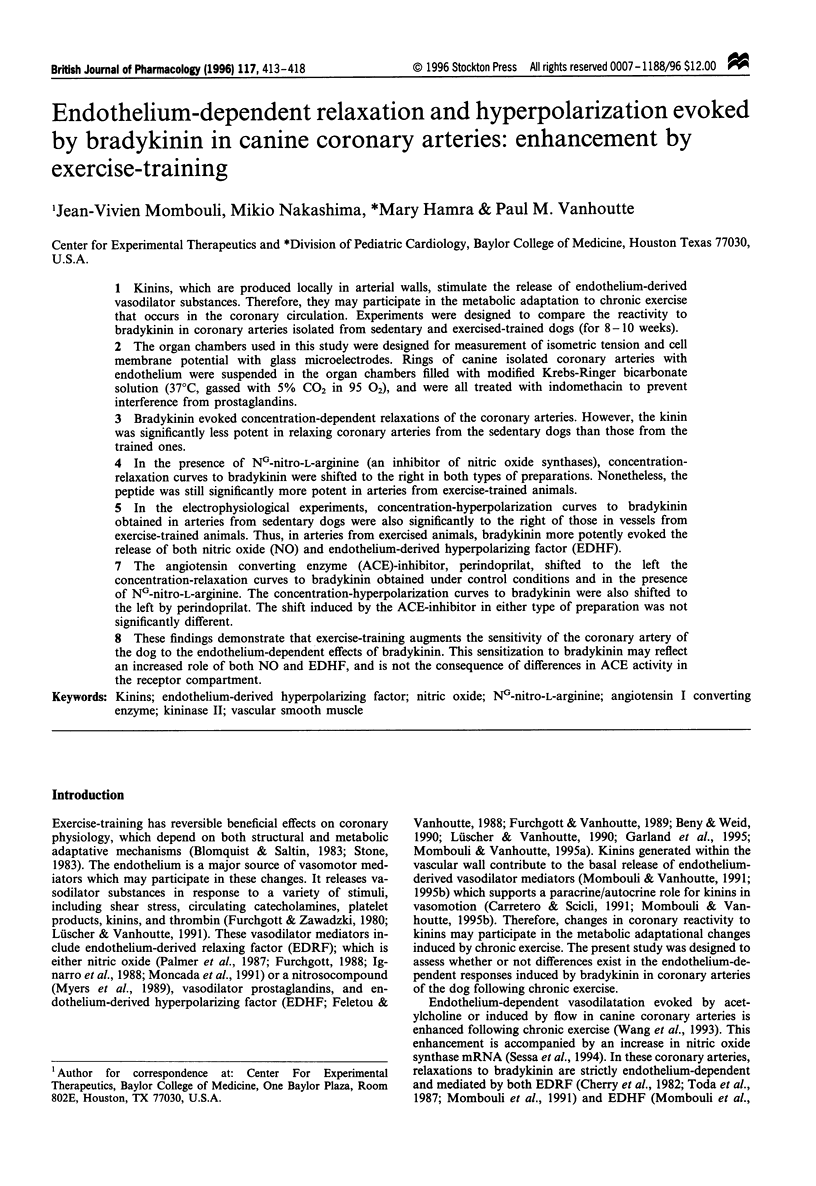
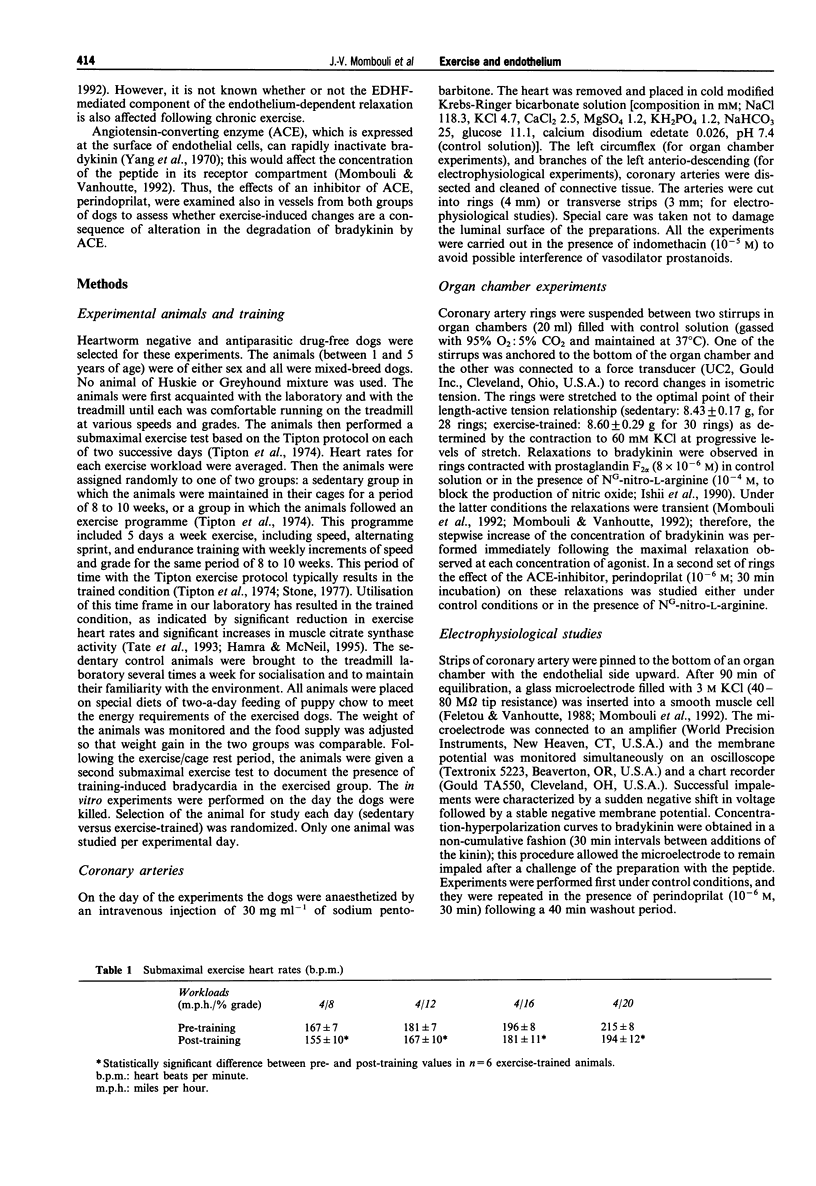

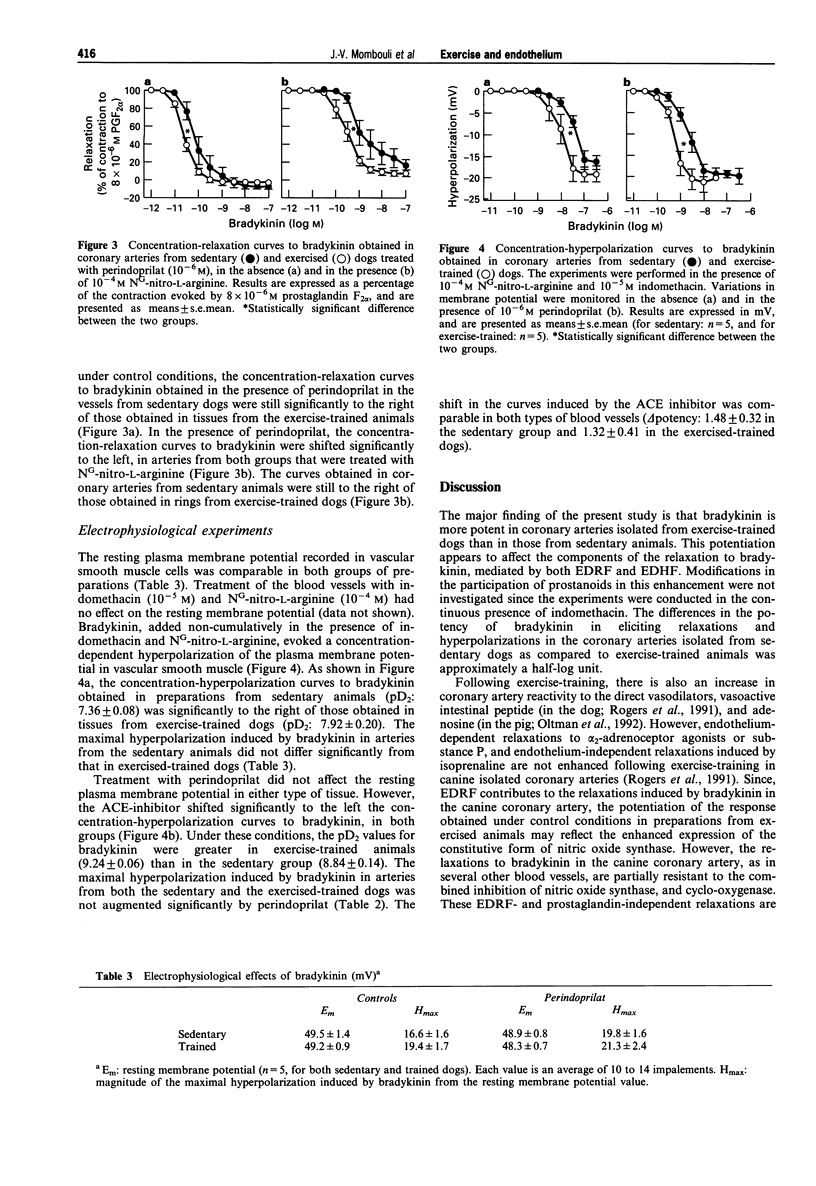
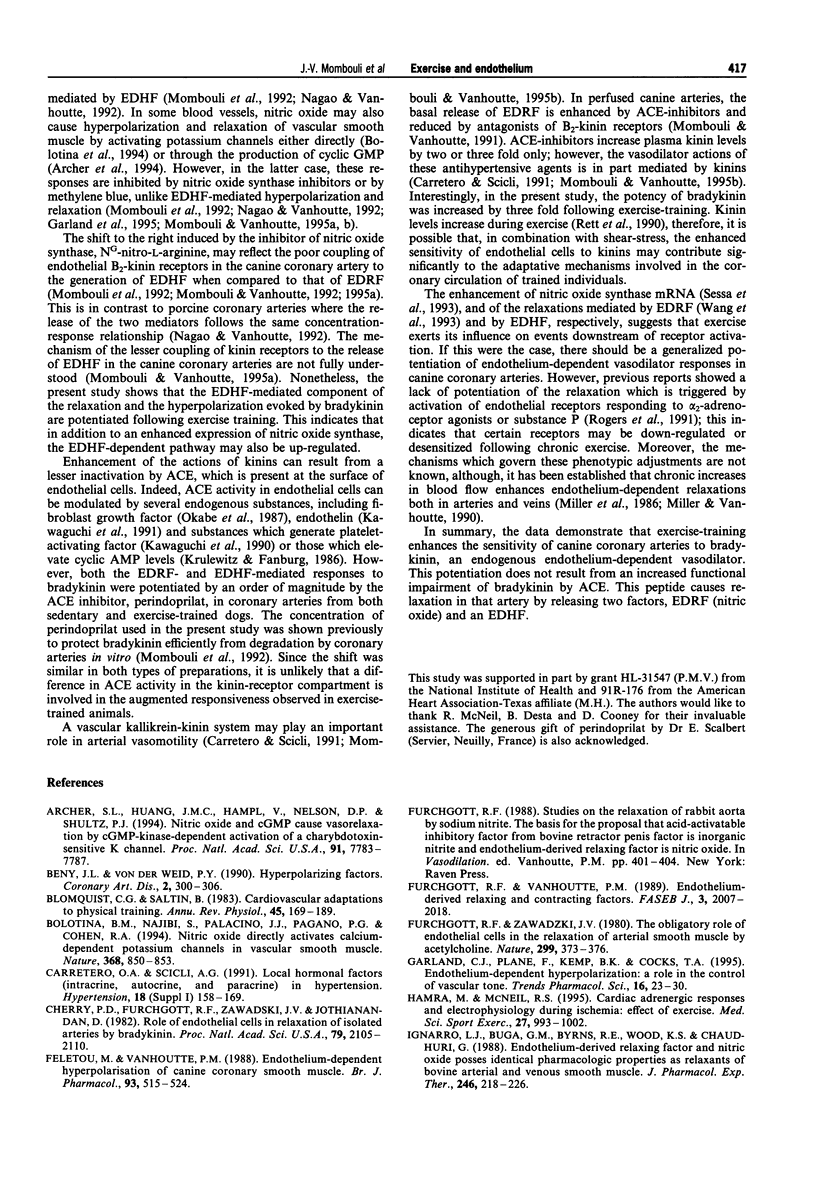
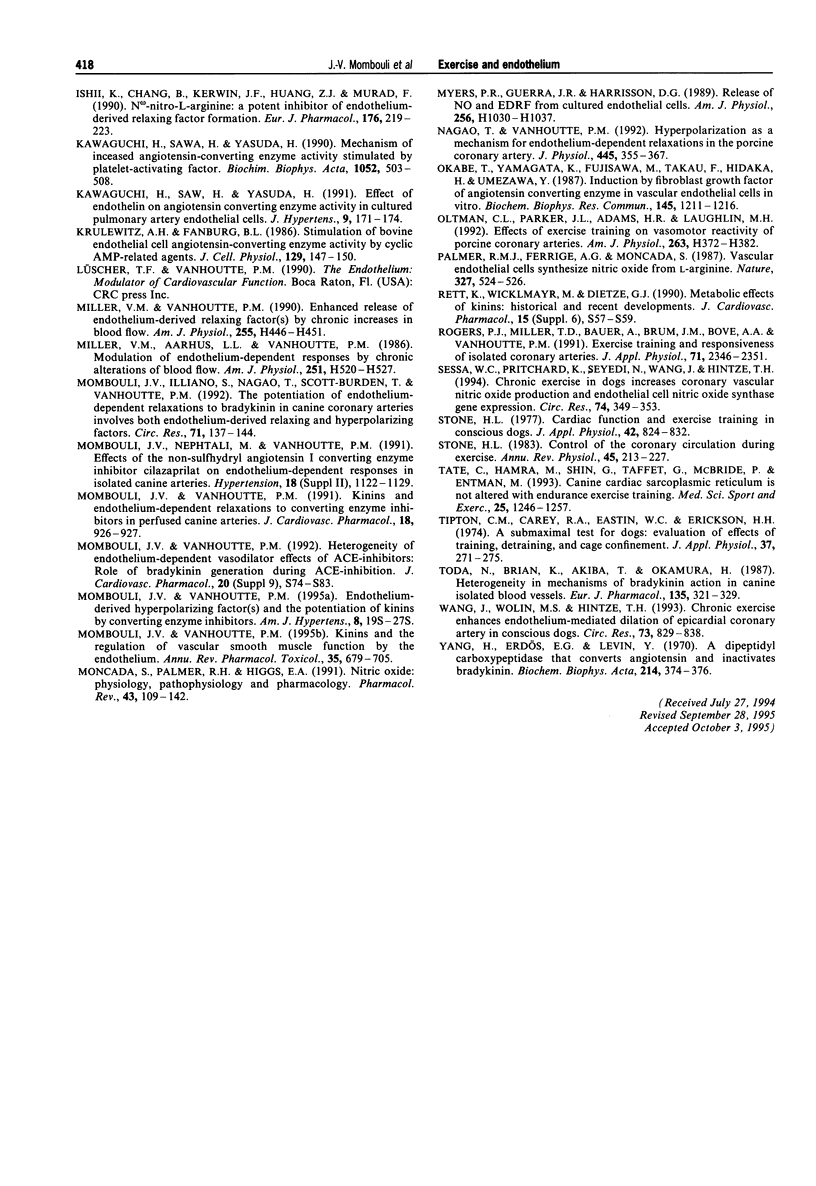
Selected References
These references are in PubMed. This may not be the complete list of references from this article.
- Blomqvist C. G., Saltin B. Cardiovascular adaptations to physical training. Annu Rev Physiol. 1983;45:169–189. doi: 10.1146/annurev.ph.45.030183.001125. [DOI] [PubMed] [Google Scholar]
- Bolotina V. M., Najibi S., Palacino J. J., Pagano P. J., Cohen R. A. Nitric oxide directly activates calcium-dependent potassium channels in vascular smooth muscle. Nature. 1994 Apr 28;368(6474):850–853. doi: 10.1038/368850a0. [DOI] [PubMed] [Google Scholar]
- Feletou M., Vanhoutte P. M. Endothelium-dependent hyperpolarization of canine coronary smooth muscle. Br J Pharmacol. 1988 Mar;93(3):515–524. doi: 10.1111/j.1476-5381.1988.tb10306.x. [DOI] [PMC free article] [PubMed] [Google Scholar]
- Furchgott R. F., Vanhoutte P. M. Endothelium-derived relaxing and contracting factors. FASEB J. 1989 Jul;3(9):2007–2018. [PubMed] [Google Scholar]
- Furchgott R. F., Zawadzki J. V. The obligatory role of endothelial cells in the relaxation of arterial smooth muscle by acetylcholine. Nature. 1980 Nov 27;288(5789):373–376. doi: 10.1038/288373a0. [DOI] [PubMed] [Google Scholar]
- Garland C. J., Plane F., Kemp B. K., Cocks T. M. Endothelium-dependent hyperpolarization: a role in the control of vascular tone. Trends Pharmacol Sci. 1995 Jan;16(1):23–30. doi: 10.1016/s0165-6147(00)88969-5. [DOI] [PubMed] [Google Scholar]
- Hamra M., McNeil R. S. Cardiac adrenergic responses and electrophysiology during ischemia: effect of exercise. Med Sci Sports Exerc. 1995 Jul;27(7):993–1002. doi: 10.1249/00005768-199507000-00007. [DOI] [PubMed] [Google Scholar]
- Ignarro L. J., Buga G. M., Byrns R. E., Wood K. S., Chaudhuri G. Endothelium-derived relaxing factor and nitric oxide possess identical pharmacologic properties as relaxants of bovine arterial and venous smooth muscle. J Pharmacol Exp Ther. 1988 Jul;246(1):218–226. [PubMed] [Google Scholar]
- Ishii K., Chang B., Kerwin J. F., Jr, Huang Z. J., Murad F. N omega-nitro-L-arginine: a potent inhibitor of endothelium-derived relaxing factor formation. Eur J Pharmacol. 1990 Feb 6;176(2):219–223. doi: 10.1016/0014-2999(90)90531-a. [DOI] [PubMed] [Google Scholar]
- Kawaguchi H., Sawa H., Yasuda H. Effect of endothelin on angiotensin converting enzyme activity in cultured pulmonary artery endothelial cells. J Hypertens. 1991 Feb;9(2):171–174. doi: 10.1097/00004872-199102000-00012. [DOI] [PubMed] [Google Scholar]
- Kawaguchi H., Sawa H., Yasuda H. Mechanism of increased angiotensin-converting enzyme activity stimulated by platelet-activating factor. Biochim Biophys Acta. 1990 May 22;1052(3):503–508. doi: 10.1016/0167-4889(90)90162-7. [DOI] [PubMed] [Google Scholar]
- Krulewitz A. H., Fanburg B. L. Stimulation of bovine endothelial cell angiotensin-I-converting enzyme activity by cyclic AMP-related agents. J Cell Physiol. 1986 Nov;129(2):147–150. doi: 10.1002/jcp.1041290204. [DOI] [PubMed] [Google Scholar]
- Miller V. M., Aarhus L. L., Vanhoutte P. M. Modulation of endothelium-dependent responses by chronic alterations of blood flow. Am J Physiol. 1986 Sep;251(3 Pt 2):H520–H527. doi: 10.1152/ajpheart.1986.251.3.H520. [DOI] [PubMed] [Google Scholar]
- Miller V. M., Vanhoutte P. M. Enhanced release of endothelium-derived factor(s) by chronic increases in blood flow. Am J Physiol. 1988 Sep;255(3 Pt 2):H446–H451. doi: 10.1152/ajpheart.1988.255.3.H446. [DOI] [PubMed] [Google Scholar]
- Mombouli J. V., Illiano S., Nagao T., Scott-Burden T., Vanhoutte P. M. Potentiation of endothelium-dependent relaxations to bradykinin by angiotensin I converting enzyme inhibitors in canine coronary artery involves both endothelium-derived relaxing and hyperpolarizing factors. Circ Res. 1992 Jul;71(1):137–144. doi: 10.1161/01.res.71.1.137. [DOI] [PubMed] [Google Scholar]
- Mombouli J. V., Vanhoutte P. M. Endothelium-derived hyperpolarizing factor(s) and the potentiation of kinins by converting enzyme inhibitors. Am J Hypertens. 1995 May;8(5 Pt 2):19S–27S. doi: 10.1016/0895-7061(95)00029-o. [DOI] [PubMed] [Google Scholar]
- Mombouli J. V., Vanhoutte P. M. Heterogeneity of endothelium-dependent vasodilator effects of angiotensin-converting enzyme inhibitors: role of bradykinin generation during ACE inhibition. J Cardiovasc Pharmacol. 1992;20 (Suppl 9):S74–S82. [PubMed] [Google Scholar]
- Mombouli J. V., Vanhoutte P. M. Kinins and endothelial control of vascular smooth muscle. Annu Rev Pharmacol Toxicol. 1995;35:679–705. doi: 10.1146/annurev.pa.35.040195.003335. [DOI] [PubMed] [Google Scholar]
- Mombouli J. V., Vanhoutte P. M. Kinins and endothelium-dependent relaxations to converting enzyme inhibitors in perfused canine arteries. J Cardiovasc Pharmacol. 1991 Dec;18(6):926–927. doi: 10.1097/00005344-199112000-00021. [DOI] [PubMed] [Google Scholar]
- Moncada S., Palmer R. M., Higgs E. A. Nitric oxide: physiology, pathophysiology, and pharmacology. Pharmacol Rev. 1991 Jun;43(2):109–142. [PubMed] [Google Scholar]
- Myers P. R., Guerra R., Jr, Harrison D. G. Release of NO and EDRF from cultured bovine aortic endothelial cells. Am J Physiol. 1989 Apr;256(4 Pt 2):H1030–H1037. doi: 10.1152/ajpheart.1989.256.4.H1030. [DOI] [PubMed] [Google Scholar]
- Nagao T., Vanhoutte P. M. Hyperpolarization as a mechanism for endothelium-dependent relaxations in the porcine coronary artery. J Physiol. 1992 Jan;445:355–367. doi: 10.1113/jphysiol.1992.sp018928. [DOI] [PMC free article] [PubMed] [Google Scholar]
- Okabe T., Yamagata K., Fujisawa M., Takaku F., Hidaka H., Umezawa Y. Induction by fibroblast growth factor of angiotensin converting enzyme in vascular endothelial cells in vitro. Biochem Biophys Res Commun. 1987 Jun 30;145(3):1211–1216. doi: 10.1016/0006-291x(87)91566-x. [DOI] [PubMed] [Google Scholar]
- Oltman C. L., Parker J. L., Adams H. R., Laughlin M. H. Effects of exercise training on vasomotor reactivity of porcine coronary arteries. Am J Physiol. 1992 Aug;263(2 Pt 2):H372–H382. doi: 10.1152/ajpheart.1992.263.2.H372. [DOI] [PubMed] [Google Scholar]
- Palmer R. M., Ferrige A. G., Moncada S. Nitric oxide release accounts for the biological activity of endothelium-derived relaxing factor. Nature. 1987 Jun 11;327(6122):524–526. doi: 10.1038/327524a0. [DOI] [PubMed] [Google Scholar]
- Rett K., Wicklmayr M., Dietze G. J. Metabolic effects of kinins: historical and recent developments. J Cardiovasc Pharmacol. 1990;15 (Suppl 6):S57–S59. [PubMed] [Google Scholar]
- Rogers P. J., Miller T. D., Bauer B. A., Brum J. M., Bove A. A., Vanhoutte P. M. Exercise training and responsiveness of isolated coronary arteries. J Appl Physiol (1985) 1991 Dec;71(6):2346–2351. doi: 10.1152/jappl.1991.71.6.2346. [DOI] [PubMed] [Google Scholar]
- Sessa W. C., Pritchard K., Seyedi N., Wang J., Hintze T. H. Chronic exercise in dogs increases coronary vascular nitric oxide production and endothelial cell nitric oxide synthase gene expression. Circ Res. 1994 Feb;74(2):349–353. doi: 10.1161/01.res.74.2.349. [DOI] [PubMed] [Google Scholar]
- Stone H. L. Cardiac function and exercise training in conscious dogs. J Appl Physiol Respir Environ Exerc Physiol. 1977 Jun;42(6):824–832. doi: 10.1152/jappl.1977.42.6.824. [DOI] [PubMed] [Google Scholar]
- Stone H. L. Control of the coronary circulation during exercise. Annu Rev Physiol. 1983;45:213–227. doi: 10.1146/annurev.ph.45.030183.001241. [DOI] [PubMed] [Google Scholar]
- Tate C., Hamra M., Shin G., Taffet G., McBride P., Entman M. Canine cardiac sarcoplasmic reticulum is not altered with endurance exercise training. Med Sci Sports Exerc. 1993 Nov;25(11):1246–1257. [PubMed] [Google Scholar]
- Tipton C. M., Carey R. A., Eastin W. C., Erickson H. H. A submaximal test for dogs: evaluation of effects of training, detraining, and cage confinement. J Appl Physiol. 1974 Aug;37(2):271–275. doi: 10.1152/jappl.1974.37.2.271. [DOI] [PubMed] [Google Scholar]
- Toda N., Bian K., Akiba T., Okamura T. Heterogeneity in mechanisms of bradykinin action in canine isolated blood vessels. Eur J Pharmacol. 1987 Mar 31;135(3):321–329. doi: 10.1016/0014-2999(87)90681-9. [DOI] [PubMed] [Google Scholar]
- Wang J., Wolin M. S., Hintze T. H. Chronic exercise enhances endothelium-mediated dilation of epicardial coronary artery in conscious dogs. Circ Res. 1993 Nov;73(5):829–838. doi: 10.1161/01.res.73.5.829. [DOI] [PubMed] [Google Scholar]
- Yang H. Y., Erdös E. G., Levin Y. A dipeptidyl carboxypeptidase that converts angiotensin I and inactivates bradykinin. Biochim Biophys Acta. 1970 Aug 21;214(2):374–376. doi: 10.1016/0005-2795(70)90017-6. [DOI] [PubMed] [Google Scholar]


